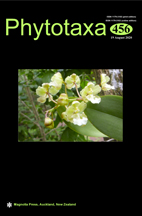Abstract
A new fungus, Muyocopron thailandica, collected from a dead plant sample in northern Thailand, is described and compared with other described species of Muyocopron. Multi-gene phylogenetic analyses based on LSU and ITS sequence data indicated that M. thailandica forms a distinct lineage within the genus Muyocopron, and is closely related to M. castanopsis and M. lithocarpi. Muyocopron thailandica differs from these two species in having ellipsoid to subcylindrical asci, with a very short and thin pedicel and oval to obovoid ascospores. Asci and ascospores of M. thailandica are larger than those of M. castanopsis and M. lithocarpi. Morphological description and a detailed illustration of the new species are provided.

